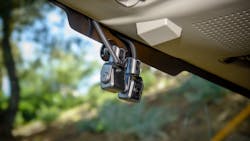Video Aids Agency Monitoring Efforts
The security of buses is a top issue for agencies; safer transport means increased ridership. One method to enhance safety is through the use of security cameras.
“We, physically on a transit bus, will install a few or up to six or seven cameras. The driver can activate a manual button if they’re having an issue with a passenger or if there is an incident on the bus. In some cases, we will install multiple buttons throughout the bus. For example, we have a button on the wheelchair ramp [that a person] can push to activate the cameras,” said Jason Palmer, chief operating officer, SmartDrive.
Palmer said that the footage is then stored on SmartDrive’s cloud-data store.
“[Our system] will record footage and start offloading that to our cloud-data store and also send out an alert to dispatch or a manager – however it is set up – to let them know that there has been an incident on the bus.” said Palmer.
SmartDrive’s equipment can come with a cellular subscription. Palmer added that around 90 percent of agencies that utilize SmartDrive use the cellular subscription as opposed to WiFi.
“All of our equipment is sold along with the service, so if for example, there was a passenger incident it will go to one of our analysts, who will mark that there was a passenger incident on the bus if you need to find, locate and keep records of [an incident],” said Palmer.
One thing that always comes into question when surveillance is how effective it is.
“It’s not just the resolution, but also the definition of the image and the color processing of the image. We’ve implemented cameras that have high dynamic range functionality, which allows the cameras to be enhanced quite a bit, giving a much sharper and brighter image,” explained Palmer. “We also have engineered and developed very strong night vision capabilities, so that you are able to see around the bus even at nighttime. It will enhance the image so that you can exactly what is happening in and around the bus.”
Palmer notes that the system is able to start recording as soon as there is an incident, but the speed of the video’s offloading is determined by the resolution at which it is being transferred, as well as if it is being sent via WiFi or cellular network.
“For our system, if [a person] activates the manual button, it will immediately start recording and offloading, but it is not a live view into the bus. It is delayed as it is being offloaded and stored in the cloud. One of the trade-offs of is that if you are doing a live view of the bus, it may not be as high of resolution as it is trying to adjust itself to the available bandwidth,” said Palmer.
The company has also seen a branch off into different transportation modes.
“For a long time, investment for fixed route buses for a DVR would be justified. We’re seeing a lot more systems on paratransit and smaller vehicles that, in the past, may not have had a video system. Agencies are seeing a return on investment for those camera systems. We’re seeing more cameras, in the past, we may have seen two cameras, now we’re seeing a lot more implementation to have four or more cameras,” explained Palmer. “As we do that, we have larger hard-drives, it has become more of the norm now, they have longer life and are easier to maintain.”
SmartDrive is branching further into the security side of the transit industry, but also offers technology that can determine what is happening outside the bus.
“We’ve [developed] our radio-based camera system to be able to implement more computer vision and learning capabilities so that we’re able to accurately identify things like signs, signals and pedestrians if the bus is moving,” said Palmer. “I think that the industry is moving more towards intelligent smart cameras that can help the driver see and alert them of safety issues that are happening around the vehicle.”
As technology continues to develop, there are continuing trends that are appearing in the field.
“I think that we will continue to see computer vision capabilities, whether it is passenger counting or security or safety. We’ll see cameras not just used for recording video, but being fully capable for doing intelligent things to assist the transit agency,” added Palmer.
